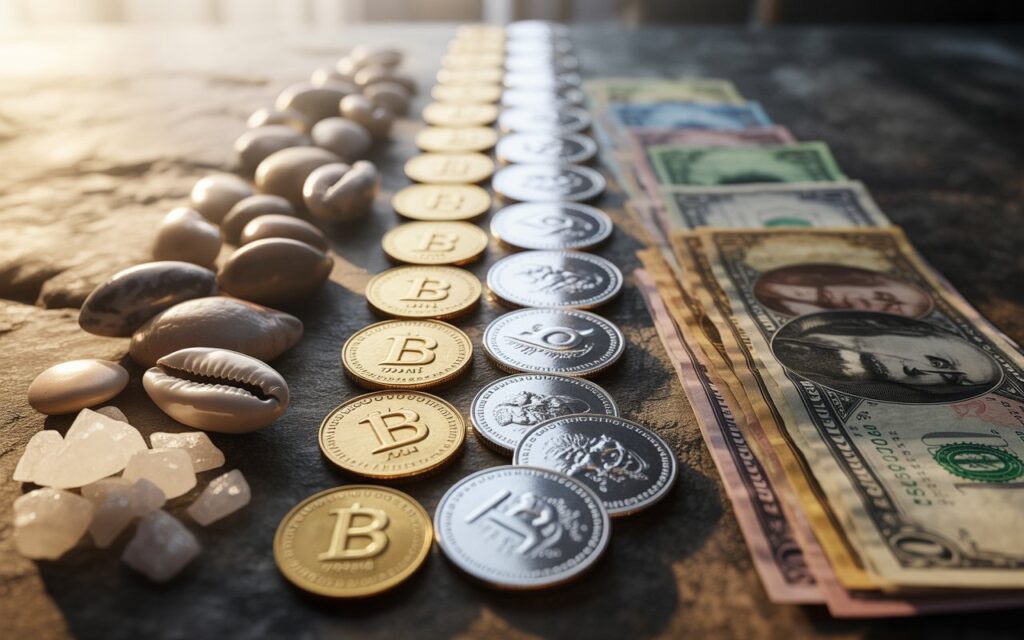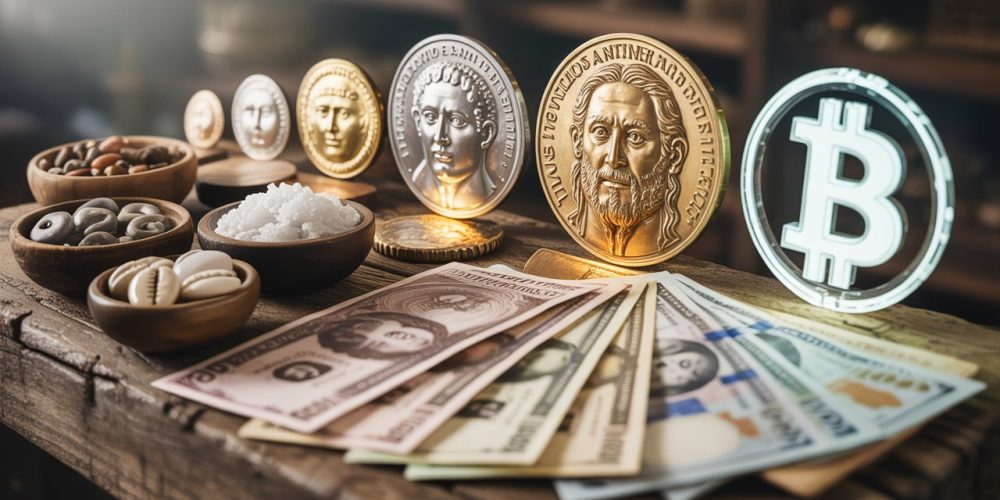
The Inflation Deception: Why Your Savings Are Designed to Fail and How to Build Real Wealth
In the grand theater of modern economics, few concepts are as misunderstood as money and inflation. We work for it, save it, and are told it is the bedrock of our financial security. Yet, its value silently erodes over time, a process so gradual it often goes unnoticed until it’s too late. This is not an accident. It is the logical outcome of a system designed to transfer wealth from the unaware to the aware. This article will embark on a journey through three critical areas: first, we will uncover the true nature of money and its dramatic transformation over the last century. Second, we will demystify inflation, revealing it not as a random economic bug, but as a powerful and deliberate policy tool. Finally, we will construct a practical, step-by-step ladder for you to climb, allowing you to escape the trap of paper currency and build a fortress of lasting wealth. This is the essential guide to inflation and wealth preservation.
∎ The Unchaining of Money – From Tangible Gold to Intangible Trust
The story of modern money is a story of separation a slow, deliberate uncoupling from tangible reality into the realm of pure trust and government decree. To understand why our savings are vulnerable, we must first understand what money once was, and what it has become.
The Age of Commodity and Sound Money
For millennia, money was not a piece of paper or a digital number. It was a commodity. Early societies used salt, cattle, shells, and other items of intrinsic value as a medium of exchange. These were imperfect, but they shared a crucial characteristic: the money was the wealth.
This eventually led to the adoption of precious metals, primarily gold and silver, as the preferred form of money. Why? They possessed unique qualities that made them ideal:
- Durability: They do not rust or decay.
- Divisibility: They can be divided into smaller units without losing value.
- Portability: They are easy to carry and transport.
- Scarcity: Their supply is limited, making them a reliable store of value.
This system, often called “sound money,” meant that every coin in your pocket held real, intrinsic value. The value was in the metal itself. This created a natural discipline on governments and kings. They could not easily fund wars or expansive projects by simply creating more money; they had to have the physical gold or silver to mint the coins. This link between money and a real, scarce asset acted as a powerful check on fiscal irresponsibility.
The Rise of Paper Receipts and the Gold Standard
Carrying large amounts of gold was cumbersome and risky. This led to the innovation of goldsmiths, who would securely store people’s gold and issue them paper receipts. These receipts were, in essence, “as good as gold.” Soon, people began trading the receipts directly, as it was more convenient than trading the physical metal. This was the birth of paper money, but it was fundamentally different from today’s currency. Each paper bill was a claim check on a specific amount of gold held in reserve.
This informal system eventually became formalized into the Gold Standard. Under a strict gold standard, a nation’s currency supply is directly tied to its gold reserves. For example, the U.S. dollar was defined as a specific weight of gold (e.g., $20.67 per ounce of gold until 1933). This meant that, in theory, you could walk into a bank and exchange your paper dollars for physical gold. This system enforced international trade balance and provided a stable environment for long-term capital investment. It was the bedrock of the global economy for much of the 19th and early 20th centuries.
The Breaking of the Link: The Bretton Woods Agreement and the Fiat Era
The discipline of the gold standard was seen as a major obstacle during times of crisis, particularly World War I and the Great Depression. Governments wanted the ability to print money to fund war efforts and stimulate their economies, something the gold standard forbade.
The final, fatal blow came in 1944 with the Bretton Woods Agreement. While this system still pegged global currencies to the U.S. dollar, and the dollar was still convertible to gold for foreign nations, it was a diluted version of the gold standard. It created a new global order with the U.S. dollar at its center. However, the pressure to print money to fund domestic programs and the Vietnam War proved too great.
On August 15, 1971, President Richard Nixon officially severed the dollar’s convertibility to gold. This was one of the most significant economic events in modern history. In a single day, money was unchained from any physical asset. It became fiat currency money backed by nothing but the “full faith and credit” of the government that issued it. Its value derived from legal tender laws (you must accept it for payment of debts) and collective confidence.
This transition from sound money to fiat currency is the foundational event that enables the modern challenges of wealth preservation. With the physical restraint gone, the supply of money could now be expanded at will, setting the stage for inflation to become a permanent, engineered feature of our economic system.
∎ Inflation as a Policy Tool – The Hidden Tax and Wealth Shifter
With the creation of a limitless supply of fiat money, a new dynamic emerged. Inflation, once a rare and often disastrous event (like the Weimar Republic hyperinflation), became a persistent, managed policy. It is often presented to the public as a sign of a “growing economy,” but a deeper look reveals its true function as a powerful tool for policy makers.
What is Inflation, Really?
At its core, inflation is not simply “prices going up.” That is the symptom. The cause is an expansion of the money supply that outpaces the growth of goods and services in an economy. When there is more money chasing the same amount of goods, prices must rise. It’s a simple matter of supply and demand.
Imagine an island with 100 apples and 100 dollars in circulation. Each apple costs $1. If a helicopter flies over and drops another 100 dollars, now there are 200 dollars chasing the same 100 apples. The price of each apple will naturally rise to $2. The apples didn’t become more valuable; the dollars became less valuable. This is the essence of inflation: a devaluation of the currency.
The Four Pillars of Inflationary Policy
Why would a government want to devalue its own currency? Because it provides four powerful, albeit hidden, benefits. This is why many economists and analysts argue that inflation is not a bug in the system, but a core feature.
- It Reduces the Real Value of Government Debt: This is perhaps the most important incentive. Modern governments carry enormous levels of debt. By creating inflation, they can pay back that debt with “cheaper” dollars in the future. If a government owes $1 trillion, and they create 5% annual inflation, the real value of that debt is reduced by 5% each year. It is a form of stealth default, allowing them to transfer the burden of their past spending onto savers and fixed-income citizens.
- It Shifts Wealth from Savers to Spenders: Inflation punishes those who hold cash or savings in a bank account. The purchasing power of their saved money silently erodes. Conversely, it encourages spending and investment. If your money is losing value, you are incentivized to spend it now or put it into assets that might keep pace with inflation. This creates economic activity (a rising GDP), which politicians can point to as a success, even if it’s built on a foundation of devaluation.
- It Inflates Asset Prices (Benefiting the Rich): The newly created money doesn’t get distributed evenly. It is injected into the economy at specific points, usually through the banking system and large financial institutions. This new money flows first into stocks, bonds, and real estate. This inflates the prices of these assets, disproportionately benefiting the wealthy, who own the vast majority of them. The average person sees the price of their groceries and gas go up, while the rich see their net worth soar. This is a key driver of wealth inequality.
- It’s a Hidden Tax (Unlike Overt Taxes): Raising direct taxes is politically unpopular and can lead to public unrest. Inflation acts as a hidden tax on everyone’s purchasing power. It is a slow, silent erosion of wealth that most people don’t connect to government policy. It allows governments to fund their operations by effectively taxing the cash holdings of the entire population, without ever passing a tax law.
Understanding these four points is to understand the modern financial system. It is a system where currency is not a stable store of value, but a tool of policy. Recognizing this is the first and most critical step toward achieving genuine inflation and wealth preservation.
∎ The Wealth Ladder – A 5-Step Escape Plan from Paper Money
If the system is designed to devalue the currency you work for, then playing by the old rules of “saving money” is a guaranteed losing strategy. You must change the game. The solution is to systematically climb what we call “The Wealth Ladder” a process of moving your energy from holding paper currency to owning things of real, intrinsic, and productive value.
Step 1: Understand the Game and Shift Your Mindset
You cannot win a game you don’t understand. The first step is a mental shift. Stop seeing your bank account balance as your ultimate wealth. It is a temporary tool for transactions, not a long-term store of value. Your primary financial goal is no longer to “accumulate dollars,” but to “accumulate assets that preserve and grow your purchasing power over time.” This shift in perspective is the foundation upon which all other steps are built. You must accept that the rules are stacked against the passive saver.
Step 2: Move to Relative Stability (Defensive Position)
For many, especially those in countries with volatile local currencies, the first practical move is defensive. If your national currency is rapidly devaluing, holding it is an immediate loss. The second rung on the ladder is to convert your savings into a more stable, globally recognized fiat currency like the U.S. Dollar or the Euro.
- Why? While these currencies are also subject to inflation, they are generally more stable and widely accepted. This move is not about creating wealth, but about preserving the wealth you have while you prepare for the next step. It’s like moving from a leaking rowboat to a more sturdy ship. You’re still in the water, but you’re in a much safer position.
Step 3: Convert to Real, Hard Assets (Your Fortress)
This is where you begin to truly escape the paper money system. Real assets are things that cannot be printed out of thin air. They have intrinsic value and are a historical hedge against currency devaluation.
- Precious Metals (Gold & Silver): For thousands of years, gold has been the ultimate store of value. It is nobody’s liability, and its purchasing power has remained remarkably stable over centuries. Holding physical gold or silver is your primary defense against systemic risk and monetary insanity. It is the foundation of your financial fortress.
- Land: As Mark Twain famously said, “Buy land, they’re not making it anymore.” Land is a tangible, finite resource. Whether it’s agricultural land, timberland, or a plot for development, it holds real value and can produce income.
Step 4: Acquire Producing Assets (The Engine of Wealth)
While hard assets preserve wealth, producing assets grow it. These are assets that generate cash flow, putting money in your pocket regardless of what the currency is doing. This is how you get ahead of inflation.
- Income-Producing Real Estate: Rental properties that generate monthly cash flow after expenses. The value of the property may rise with inflation, but the steady income stream is the real prize.
- Businesses: Owning a stake in a profitable business (whether your own or through equity investments) is one of the most powerful wealth-building tools. A good business can raise its prices to keep pace with inflation, protecting its margins and rewarding its owners.
- Energy & Infrastructure: Assets that provide essential services like oil and gas wells, solar farms, or cell towers that fuel the economy and generate consistent, long-term revenue.
Step 5: Create Your Own Intrinsic Value (The Ultimate Asset)
The highest and most secure rung on the Wealth Ladder is an asset that cannot be taken away from you and is not subject to market fluctuations: your own unique ability to create value.
- Skills and Knowledge: Investing in yourself learning high-demand skills, mastering a craft, becoming a leader in your field is the ultimate form of wealth preservation. Your ability to produce value, solve problems, and generate income is your most powerful asset.
- Your Brand and Intellectual Property: Building a personal brand, a loyal audience, or creating intellectual property (a book, a patent, a course) creates long-term, scalable value that can pay you for years to come. This is the wealth that is truly yours, independent of any government or financial system.
By systematically climbing this ladder, you move from being a victim of the system to a master of your own financial destiny. You stop playing the game of paper money and start playing the game of real value. This is the path not just to wealth, but to lasting financial freedom in a world of constant change.


